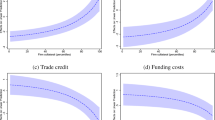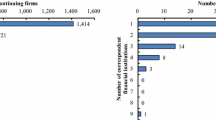Abstract
This paper examines empirically the effects of multiple banking relationships on the cost and availability of credit. The analysis is based on an unbalanced panel data set for Japanese small and medium-sized firms over the period 2000–2002. The Hausman-Taylor estimator is used to allow for possible correlation between unobservable heterogeneity among firms and multiple banking relationships. The results suggest that the cost of credit is positively correlated with the number of banking relationships when the endogeneity of banking relationships is taken into account. Multiple banking relationships have a positive effect on the availability of credit for financially constrained firms.
Similar content being viewed by others
Notes
For more details, see Allen and Gale (2000).
The median number of banking relationships in Japan is seven for listed firms (Ogawa et al. 2007) and four for the SMEs in this paper.
Ministry of Internal Affairs and Communications, 2006 Establishment and Enterprise Census of Japan. The number of enterprises here is the number of companies as defined under SME Basic Law plus the number of self-employed persons.
The employment figure is calculated based on the 2006 Establishment and Enterprise Census of Japan, Ministry of Internal Affairs and Communications, while the value added figure is calculated from the 2007 Census of Manufactures, Ministry of Economy, Trade, and Industry.
The lending share is calculated based on Loans and Discounts Outstanding by Sector at the end of 2002, Bank of Japan.
The only exception is the study by Horiuchi (1994), which provides a descriptive investigation of the number of firms’ banking relationships by firm size based on survey data.
A survey of more general issues regarding relationship banking is provided by Boot (2000).
Other than the number of banking relationships, the strength of banking relationships is measured in various ways, such as the duration of a bank-firm relationship (Petersen and Rajan 1994, 1995; Cole 1998; Degryse and Van Cayseele 2000; Lehmann and Neuberger 2001) and the number of different services the firm purchases from the bank (Degryse and Van Cayseele 2000).
A study that does relax the strict exogeneity assumption is D'Auria et al. (1999), which employs a within estimator to measure the effect of banking relationships on the interest rate of loans to large and medium-sized Italian firms.
It is difficult to construct measures for firms’ banking relationships for the period before 2002. In the JADE database, information on firms’ banks is updated every fiscal year. Therefore, the database does not hold information on the names of firms’ past banks. Another potential source of such information is Teikoku Data Bank Kaisha Nenkan published annually by Teikoku Data Bank. However, in this publication, not all bank information is provided because of space limitations. Moreover, Teikoku Data Bank keeps the Teikoku Data Bank Kaisha Nenkan only for a year after its publication. Thus, it is almost impossible to obtain data on SMEs’ banking relationships for the period before 2002. However, it is not unreasonable to assume that firms’ banking relationships are stable over a short period of time. The stability of banking relationships is checked by analyzing whether firms changed their first bank during the period 2002–2005. It is found that only 3% of the sample firms did so during this period, and there are few reasons to believe that such stability should not also be found in the period 2000–2002.
The rationale for this approach is that it is impossible to calculate the q ratio for sample firms individually because the sample consists of small unlisted firms.
In the case of a balanced panel, θ i is constant across firms and is omitted when computing firm-mean instruments. However, in the case of an unbalanced panel, θ i is not constant across firms and it is necessary to employ a firm-specific weighting scale parameter (Gardner 1998).
Time invariant variables include, for example, a dummy for firms that are incorporated, industry dummies, and prefecture dummies. These variables do not vary throughout the sample period. The number of banking relationships and the dummy for government-affiliated financial institutions are considered to be time-invariant for the sample period since data are available only for the year 2002. However, the assumption that the number of banking relationships is time-invariant for the sample period is not that far removed from the actual nature of banking relationships of SMEs in Japan. For more details, see footnote 12. The other variables vary year by year and are considered to be time-variant variables.
Previous studies using data on small and medium-sized firms in the U.S. define firms as constrained when they fall behind in their repayment of trade credits, because trade credits become the most expensive source of capital if repaid after the due date. In Japan, there is no discount or penalty rule in regard to the repayment of trade credits as in the U.S., where firms can get a substantial discount for early repayment.
The reason why the lagged value of sales is used instead of total assets is that the latter is highly correlated with the predicted value of loan demand calculated from the previous estimation.
The estimation results for the number of banking relationships and other variables remain the same when ln(number of branches of non-government banks) is replaced by the credit market concentration ratio defined as the lending share of the three largest banks in the prefecture. The coefficient on the credit market concentration ratio is positive and significant at the 1% level, suggesting that firms are charged higher interest rates in a concentrated credit market. This result is consistent with the results of Model I, implying that selection bias is not a serious problem.
The estimation results for this specification are available from the author upon request.
As mentioned above, a firm is defined as credit constrained in year t when the probability that the desired amount of bank credit in year t exceeds the maximum amount of credit available in the same year is greater than 0.5.
The sample mean of the total outstanding loans/total assets ratio(t-1) is 38.63% for firms with a single banking relationship, but 41.98% for firms with multiple banking relationships, and this difference is statistically significant (t-value = −6.77).
References
Allen F, Gale D (2000) Comparing financial systems. MIT, London, pp 47–73
Aoki M, Patrick H (1994) The Japanese main bank system: its relevance for developing and transforming economies. Oxford, New York, pp 3–50
Atanasova CV, Wilson N (2004) Disequilibrium in the UK corporate loan market. J Bank Financ 28:595–614
Bannier CE (2007) Heterogeneous multiple bank financing: does it reduce inefficient credit-renegotiation incidences? Fin Mkts Portfolio Mgmt 21:445–470
Berger AN, Klapper LF, Udell GF (2001) The ability of banks to lend to informationally opaque small businesses. J Bank Financ 25:2127–2167
Berger AN, Saunders A, Scalise JM, Udell GF (1998) The effects of bank mergers and acquisitions on small business lending. J Financ Econ 50:187–229
Berger AN, Udell GF (2002) Small business credit availability and relationship lending: the importance of bank organizational structure. Econ J 112:32–53
Boot AWA (2000) Relationship banking: what do we know? J Financ Intermed 9:7–25
Boot AWA, Thakor AV (2000) Can relationship banking survive competition? J Financ 55:679–713
Carletti E (2004) The structure of bank relationships, endogenous monitoring, and loan rates. J Financ Intermed 13:58–86
Cole RA (1998) The importance of relationships to the availability of credit. J Bank Financ 22:959–77
Cosci S, Meliciani V (2002) Multiple banking relationships: evidence from the Italian experience. Manch Sch 70 (Supplement 1463–6786):37–54
D'Auria C, Foglia A, Reedtz PM (1999) Bank interest rates and credit relationships in Italy. J Bank Financ 23:1067–1093
Degryse H, Van Cayseele P (2000) Relationship lending within a bank-based system: evidence from European small business data. J Financ Intermed 9:90–109
Detragiache E, Garella P, Guiso L (2000) Multiple versus single banking relationships: theory and evidence. J Financ 55:1133–1161
Diamond DW (1984) Financial intermediation and delegated monitoring. Rev Econ Stud 51:393–414
Elsas R, Heinemann F, Tyrell M (2004) Multiple but asymmetric bank financing: the case of relationship lending. CESifo Working Papar 1251
Elsas R, Krahnen JP (1998) Is relationship lending special? Evidence from credit-file data in Germany. J Bank Financ 22:1283–1316
Gardner R (1998) Unobservable individual effects in unbalanced panel data. Econ Lett 58:39–42
Gersovitz M (1980) Classification probabilities for the disequilibrium model. J Econometrics 14:239–246
Harhoff D, Körting T (1998) Lending relationships in Germany—empirical evidence from survey data. J Bank Financ 22:1317–1353
Hausman JA, Taylor WE (1981) Panel data and unobservable individual effects. Econometrica 49:1377–1398
Hellwig M (1991) Banking, financial intermediation and corporate finance. In: Giovannini A, Mayer C (eds) European financial integration. New York, Cambridge, pp 35–63
Horiuchi T (1994) The effect of firm status on banking relationships and loan syndication. In: Aoki M, Patrick H (eds) The Japanese main bank system. New York, Oxford, pp 258–294
Hoshi T, Kashyap A, Scharfstein D (1990) The role of banks in reducing the costs of financial distress in Japan. J Financ Econ 27:67–88
Hoshi T, Kashyap A, Scharfstein D (1991) Corporate structure, liquidity, and investment: evidence from Japanese industrial group. Q J Econ 106:33–60
Lehmann E, Neuberger D (2001) Do lending relationships matter? Evidence from bank survey data in Germany. J Econ Behav Organ 45:339–359
Maddala GS, Nelson FD (1974) Maximum likelihood methods for markets in disequilibrium. Econometrica 42:1013–1030
Neuberger D, Pedergnana M, Räthke S (2008) Concentration of banking relationships in Switzerland: the results of firm structure or banking market structure? J Finan Serv Res 33:101–126
Neuberger D, Räthke S (2009) Microenterprises and multiple bank relationships: the case of professionals. Small Bus Econ 32:207–229
Ogawa K, Sterken E, Tokutsu I (2007) Why do Japanese firms prefer multiple bank relationship? Some evidence from firm-level data. Econ Syst 31:49–70
Ogawa K, Suzuki K (2000) Demand for bank loans and investment under borrowing constraints: a panel study of Japanese firm data. J Jpn Int Econ 14:1–21
Rajan RG (1992) Insiders and outsiders: the choice between informed and arm’s-length debt. J Financ 47:1367–1400
Petersen MA, Rajan RG (1994) The benefits of lending relationships: evidence from small business data. J Financ 49:3–37
Petersen MA, Rajan RG (1995) The effect of credit market competition on lending relationships. Q J Econ 110:407–443
Sapienza P (2002) The effects of banking mergers on loan contracts. J Financ 57:329–367
Sharpe SA (1990) Asymmetric information, bank lending, and implicit contracts: a stylized model of customer relationships. J Financ 45:1069–1087
Stein JC (2002) Information production and capital allocation: decentralized versus hierarchical firms. J Financ 57:1891–1921
Stiglitz J, Wise A (1981) Credit rationing in markets with imperfect information. Am Econ Rev 71:393–410
von Thadden EL (1995) Long-term contracts, short-term investment and monitoring. Rev Econ Stud 62:557–575
Ziane Y (2003) Number of banks and credit relationships: empirical results from French small business data. Eur Rev Econ Financ 2:33–60
Author information
Authors and Affiliations
Corresponding author
Additional information
Acknowledgments
I am grateful to Munehisa Kasuya, Yukinobu Kitamura, Gregory F. Udell, two anonymous referees, and other seminar and conference participants at the Bank of Japan, Hitotsubashi University, Musashi University, and the annual conference of the Japan Society of Monetary Economics for their valuable and helpful comments. I also thank Hiroyuki Okamuro for his kind support in obtaining the micro data used in this paper. However, any mistakes that remain are my own.
Rights and permissions
About this article
Cite this article
Shikimi, M. Do firms benefit from multiple banking relationships? Evidence from small and medium- sized firms in Japan. Int Econ Econ Policy 10, 127–157 (2013). https://doi.org/10.1007/s10368-011-0196-x
Published:
Issue Date:
DOI: https://doi.org/10.1007/s10368-011-0196-x




